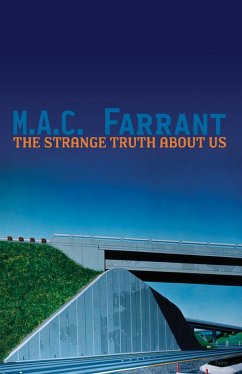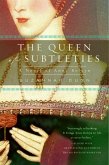Schade – dieser Artikel ist leider ausverkauft. Sobald wir wissen, ob und wann der Artikel wieder verfügbar ist, informieren wir Sie an dieser Stelle.
- Broschiertes Buch
- Merkliste
- Auf die Merkliste
- Bewerten Bewerten
- Teilen
- Produkt teilen
- Produkterinnerung
- Produkterinnerung
M.A.C. Farrant's quirky story collections have been well received. Here she presents a novel with a unique three-part structure.
Andere Kunden interessierten sich auch für
M.A.C. Farrant's quirky story collections have been well received. Here she presents a novel with a unique three-part structure.
Produktdetails
- Produktdetails
- Verlag: Talonbooks
- Seitenzahl: 208
- Erscheinungstermin: 29. November 2011
- Englisch
- Abmessung: 216mm x 139mm x 17mm
- Gewicht: 306g
- ISBN-13: 9780889226685
- ISBN-10: 0889226687
- Artikelnr.: 33269467
- Herstellerkennzeichnung
- Libri GmbH
- Europaallee 1
- 36244 Bad Hersfeld
- gpsr@libri.de
- Verlag: Talonbooks
- Seitenzahl: 208
- Erscheinungstermin: 29. November 2011
- Englisch
- Abmessung: 216mm x 139mm x 17mm
- Gewicht: 306g
- ISBN-13: 9780889226685
- ISBN-10: 0889226687
- Artikelnr.: 33269467
- Herstellerkennzeichnung
- Libri GmbH
- Europaallee 1
- 36244 Bad Hersfeld
- gpsr@libri.de
M.A.C. Farrant has been writing and publishing since the 1980s: Nineteen works of fiction, non-fiction and memoir; two produced plays, countless book reviews for the Vancouver Sun and Toronto Globe & Mail; and over a dozen chapbooks. Along with Pauline Holdstock, she ran the Sidney Reading Series from 1994-2009. Her books have been finalists for many awards, among them the Commonwealth Writer's Prize, the Ethel Wilson fiction prize, two Jessie Richardson theatre awards, The Van City Book Prize, the National Magazine Awards, the ReLit Award, the Gemini Awards for the Bravo short film adaptation of her story, Rob's Guns & Ammo, and the Victoria Book Prize (three times), the last of which she won in 2014 for her collection of miniature fiction, The World Afloat. The Strange Truth About Us was one of the Globe & Mail's Best Fiction books of 2012. Her 2021 non-fiction book, One Good Thing, was a BC Bestseller. Jigsaw: A Puzzle in Ninety-Three Pieces, another non-fiction book, was released in 2023. In 2024, Talon Books will issue the expanded 20th Anniversary Edition of her memoir, My Turquoise Years. Her most recent chapbooks are Some of the Puzzles (2021) and The Literary Cow Festival (2024) both from above/ground press in Ottawa. Talonbooks is the publisher of her last ten books. Farrant is well-known for her acerbic wit and laugh-out-loud humour. BC Bookworld has called her "Canada's most acerbic and intelligent humourist". Bill Richardson has called her "a master of the Zen-like art of delivering weight in a way that is featherlight" further noting that she's "the most accomplished and unapologetic miniaturist in Canadian letters." Archived material is in the "Special Collections Branch" at the University of Victoria.
This novel-length prose work is by turns philosophical, dark, comedic, and
lyrical in approach as it attempts to imagine a multitude of possible
futures. It is comprised of three parts and approaches the subject from
three different angles, as follows: 1. Annotations About an Absence 2.
Woman Records Brief Notes Regarding Absence 3. Other Prose Surrounding
Absence Part 1 is written as a series of numbered annotations (1-115) about
the day-long conversation/meditations between a couple who are living in a
gated community and who are attempting to create an imaginary novel in
which they express their fears about the future: Annotation #5: We concoct
a make-believe novel and a set of annotations in which... We attempt to
express the universal confusion of mind that is the main feature of
contemporary life. Which is? We are afraid. Part 2 is written as notes to
the above annotations revealing (in the spirit of transparency) the
author's sources/ideas/questions and provides a running and somewhat
satiric narrative on the subject. For example: Note #4. Images found in
works by Cormac McCarthy, JG Ballard, HG Wells, PD James; Matrix and Mad
Max films; PBS Nature segment on rise of poisonous jelly fish in world's
oceans; and content of wet Jehovah Witness pamphlet left on woman's
doorstep take hold in woman's mind. Each "note" is written as if it were a
description of a late-night TV movie; definite articles have been removed
as much as possible. Part 3 is comprised of twenty-one prose pieces which
are complimentary to Parts 1 & 2 and range in length from one page to
twenty pages. Among other things, they take aim at the individual's
existence in a globalized world wherein human existence is bludgeoned by
the threat of "end times" - climate change, species extinction, pandemics,
and really bad politics - insofar as we are able to retain our status as
"individuals". This book is an attempt by this writer - along with other
writers, thinkers, and observers - to prick the bubble of Western
complacency in the face of the "awful atrocity" which is the current world.
I would hope that the book, while unique in style and approach, is,
nonetheless, readable, engaging, enigmatic, worthy of discourse, and could
even be considered, in parts, delightful.
lyrical in approach as it attempts to imagine a multitude of possible
futures. It is comprised of three parts and approaches the subject from
three different angles, as follows: 1. Annotations About an Absence 2.
Woman Records Brief Notes Regarding Absence 3. Other Prose Surrounding
Absence Part 1 is written as a series of numbered annotations (1-115) about
the day-long conversation/meditations between a couple who are living in a
gated community and who are attempting to create an imaginary novel in
which they express their fears about the future: Annotation #5: We concoct
a make-believe novel and a set of annotations in which... We attempt to
express the universal confusion of mind that is the main feature of
contemporary life. Which is? We are afraid. Part 2 is written as notes to
the above annotations revealing (in the spirit of transparency) the
author's sources/ideas/questions and provides a running and somewhat
satiric narrative on the subject. For example: Note #4. Images found in
works by Cormac McCarthy, JG Ballard, HG Wells, PD James; Matrix and Mad
Max films; PBS Nature segment on rise of poisonous jelly fish in world's
oceans; and content of wet Jehovah Witness pamphlet left on woman's
doorstep take hold in woman's mind. Each "note" is written as if it were a
description of a late-night TV movie; definite articles have been removed
as much as possible. Part 3 is comprised of twenty-one prose pieces which
are complimentary to Parts 1 & 2 and range in length from one page to
twenty pages. Among other things, they take aim at the individual's
existence in a globalized world wherein human existence is bludgeoned by
the threat of "end times" - climate change, species extinction, pandemics,
and really bad politics - insofar as we are able to retain our status as
"individuals". This book is an attempt by this writer - along with other
writers, thinkers, and observers - to prick the bubble of Western
complacency in the face of the "awful atrocity" which is the current world.
I would hope that the book, while unique in style and approach, is,
nonetheless, readable, engaging, enigmatic, worthy of discourse, and could
even be considered, in parts, delightful.
This novel-length prose work is by turns philosophical, dark, comedic, and
lyrical in approach as it attempts to imagine a multitude of possible
futures. It is comprised of three parts and approaches the subject from
three different angles, as follows: 1. Annotations About an Absence 2.
Woman Records Brief Notes Regarding Absence 3. Other Prose Surrounding
Absence Part 1 is written as a series of numbered annotations (1-115) about
the day-long conversation/meditations between a couple who are living in a
gated community and who are attempting to create an imaginary novel in
which they express their fears about the future: Annotation #5: We concoct
a make-believe novel and a set of annotations in which... We attempt to
express the universal confusion of mind that is the main feature of
contemporary life. Which is? We are afraid. Part 2 is written as notes to
the above annotations revealing (in the spirit of transparency) the
author's sources/ideas/questions and provides a running and somewhat
satiric narrative on the subject. For example: Note #4. Images found in
works by Cormac McCarthy, JG Ballard, HG Wells, PD James; Matrix and Mad
Max films; PBS Nature segment on rise of poisonous jelly fish in world's
oceans; and content of wet Jehovah Witness pamphlet left on woman's
doorstep take hold in woman's mind. Each "note" is written as if it were a
description of a late-night TV movie; definite articles have been removed
as much as possible. Part 3 is comprised of twenty-one prose pieces which
are complimentary to Parts 1 & 2 and range in length from one page to
twenty pages. Among other things, they take aim at the individual's
existence in a globalized world wherein human existence is bludgeoned by
the threat of "end times" - climate change, species extinction, pandemics,
and really bad politics - insofar as we are able to retain our status as
"individuals". This book is an attempt by this writer - along with other
writers, thinkers, and observers - to prick the bubble of Western
complacency in the face of the "awful atrocity" which is the current world.
I would hope that the book, while unique in style and approach, is,
nonetheless, readable, engaging, enigmatic, worthy of discourse, and could
even be considered, in parts, delightful.
lyrical in approach as it attempts to imagine a multitude of possible
futures. It is comprised of three parts and approaches the subject from
three different angles, as follows: 1. Annotations About an Absence 2.
Woman Records Brief Notes Regarding Absence 3. Other Prose Surrounding
Absence Part 1 is written as a series of numbered annotations (1-115) about
the day-long conversation/meditations between a couple who are living in a
gated community and who are attempting to create an imaginary novel in
which they express their fears about the future: Annotation #5: We concoct
a make-believe novel and a set of annotations in which... We attempt to
express the universal confusion of mind that is the main feature of
contemporary life. Which is? We are afraid. Part 2 is written as notes to
the above annotations revealing (in the spirit of transparency) the
author's sources/ideas/questions and provides a running and somewhat
satiric narrative on the subject. For example: Note #4. Images found in
works by Cormac McCarthy, JG Ballard, HG Wells, PD James; Matrix and Mad
Max films; PBS Nature segment on rise of poisonous jelly fish in world's
oceans; and content of wet Jehovah Witness pamphlet left on woman's
doorstep take hold in woman's mind. Each "note" is written as if it were a
description of a late-night TV movie; definite articles have been removed
as much as possible. Part 3 is comprised of twenty-one prose pieces which
are complimentary to Parts 1 & 2 and range in length from one page to
twenty pages. Among other things, they take aim at the individual's
existence in a globalized world wherein human existence is bludgeoned by
the threat of "end times" - climate change, species extinction, pandemics,
and really bad politics - insofar as we are able to retain our status as
"individuals". This book is an attempt by this writer - along with other
writers, thinkers, and observers - to prick the bubble of Western
complacency in the face of the "awful atrocity" which is the current world.
I would hope that the book, while unique in style and approach, is,
nonetheless, readable, engaging, enigmatic, worthy of discourse, and could
even be considered, in parts, delightful.


